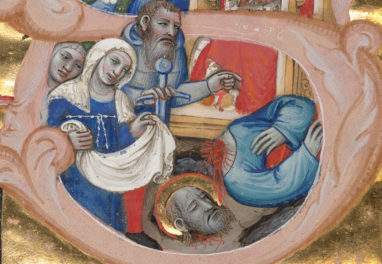
Stained glass from Canterbury Catherdral. Attributed to the Methuselah Master (English, active late 1170s). Colored glass and vitreous paint; lead came. © Robert Greshoff Photography, Courtesy Dean and Chapter of Canterbury
An introduction by Thom Kren, associate director for collections. Running time: 1:02 | Download (MP3 file, 59 MB)
England’s Canterbury Cathedral is not only a religious site—it’s a place where art flourishes. For over 14 centuries the cathedral has cultivated creative expression and welcomed artists in residence who specialize in painting, sculpture, stained glass, and many other mediums. Chaucer’s Canterbury Tales features a boisterous cast of characters on a pilgrimage to the famed site—one wonders if they also clamored to view the art within its walls.
On September 22, The Very Reverend Dr. Robert Willis, Dean of Canterbury speaks at the Getty about the cathedral’s rich artistic legacy. In anticipation of his talk, I asked Dr. Willis a few questions about the cathedral’s history and the Getty Museum’s new exhibition Canterbury and St. Albans: Treasures from Church and Cloister, which features spectacular stained glass windows on loan from the cathedral.

The Very Reverend Dr. Robert Willis, Dean of Canterbury
How do you continue to keep Canterbury Cathedral a culturally relevant institution?
Canterbury Cathedral is not only a place of international pilgrimage, it is a World Heritage Site with many departments specializing in different kinds of skills—music, stained glass, carving in stone and wood, gardening, library and archives, and many others. Each department keeps abreast of developments in its own field of activity, but at the same time is part of the large residential and working community that lives out its life here. We also receive inquiries and suggestions from cultural and academic organizations and are closely linked with the two universities here in the city. Our International Study Centre hosts consultations and conferences of all kinds throughout the year.
How does Canterbury use fine art to cross cultural and religious boundaries?
The history of Canterbury Cathedral pre-dates the divisions of the Christian church [into Catholic and Protestant] and therefore there is a sense of identity and ownership with many traditions that are quite different from the Anglicans, who act as stewards of this place at present. It is fair to say that music and art have languages that cross all barriers, and the programs put on throughout the year both in the Cathedral and in its Study Centre rely very much on fine art to break down barriers which may stand in the way of understanding. Every day people of many nations and of different faiths and traditions come here to visit us and the music and art that they find here often speak to them very powerfully in a way which words would find difficult to express.
Why is the Getty Museum a good fit for the art on view from Canterbury?
The sheer breadth of creative art on display in Canterbury Cathedral, as the result of 14 centuries of a community’s creativity and the many influences that have shaped it, tunes in well with what the Getty Museum is able to offer in another part of the world. The six panels of glass in their artistic excellence and human diversity sit well with the diversity of art that the Getty is able to exhibit, and also strengthen its encouragement to creativity amongst the people who visit the Museum.

Heather Newton, head of stone masonry and conservation at the cathedral, demonstrates stone carving techniques at the Getty Center.
The Getty recently made many images of its artworks available online through the Open Content Program , and Canterbury just did something similar with its DOCExplore program for manuscripts. How important is online access to religious and cultural institutions?
On the 13th of September, Canterbury launched its DOCexplore programme in conjunction with the University of Kent and also our friends at Rouen in France. This is only one way in which we are exploring the accessibility of manuscripts and images of artworks online, and we consider it an immensely important development for the future.
If someone is considering a visit to Canterbury Cathedral, what fact or story would you use to persuade them?
I would say to them that Canterbury Cathedral tells the story of England across the centuries since the arrival of St. Augustine in 597—in glass and wood and stone, and in artifacts and music sung daily. Even more, the living community, with its workshops and libraries, encourage people to discover within themselves gifts of their own creativity. This is a precious heritage in itself and one in which any visitor can participate. However much we can learn online and in excellent books, nothing is a substitute for being here and living the life of Canterbury, if only for a few hours.
Text of this post © J. Paul Getty Trust. All rights reserved.




Comments on this post are now closed.
Trackbacks/Pingbacks